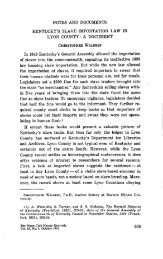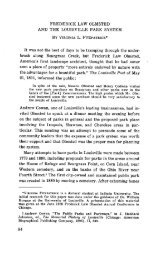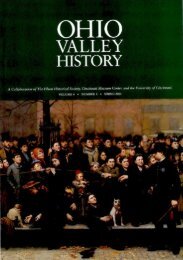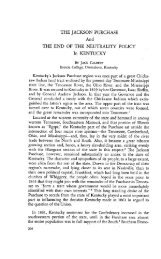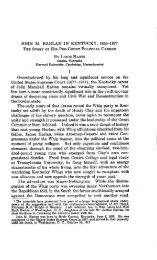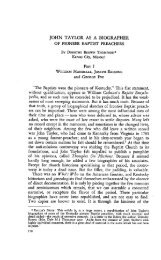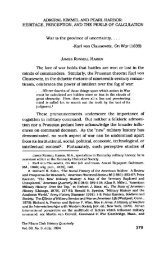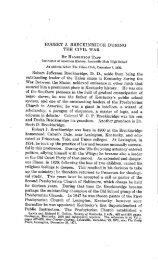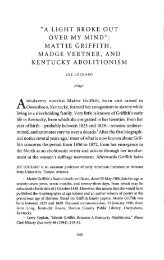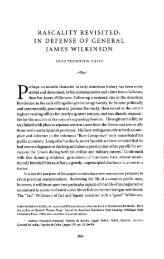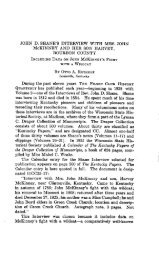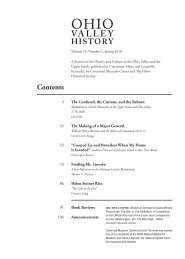the filson club history quarterly - The Filson Historical Society
the filson club history quarterly - The Filson Historical Society
the filson club history quarterly - The Filson Historical Society
Create successful ePaper yourself
Turn your PDF publications into a flip-book with our unique Google optimized e-Paper software.
1955] <strong>The</strong> Moundbuilders 225<br />
n An Osage chief in Missouri told Major Sibley, <strong>the</strong> Indiana Agent, that his people<br />
had lived at <strong>The</strong> Falls for some time, and some had had villages nearby. I was told first<br />
of <strong>the</strong>se forts by blr. <strong>The</strong>o. Chamberlain, one of <strong>the</strong> most enthusiastic and learned amateur<br />
archaeologists of <strong>The</strong> Falls region; and was taken to one of <strong>the</strong>m by his son, Mr. Carlyle<br />
D. Chamberlain.<br />
. *'One of <strong>the</strong> great mounds opened at <strong>the</strong> mouth of <strong>the</strong> Ohio (Wickliffe, Kentucky)<br />
has nothing but infant skeletons. Could <strong>the</strong>se be babes stricken by a pestilence like croup<br />
or <strong>the</strong> record of <strong>the</strong> murder of little ones <strong>the</strong>y could not carry with <strong>the</strong>m?<br />
" A distinguished Omaha Indian, Dr. Francis La Flesche, an accomplished ethnologist<br />
of <strong>the</strong> Smithsonian Institution, graciously gave me helpful interviews on two occasions.<br />
** <strong>The</strong> myster/ of <strong>the</strong> bfandans has intrigued all who knew <strong>the</strong>m. <strong>The</strong>y called <strong>the</strong>mselves<br />
People of <strong>the</strong> Ruffed Grouse a bird of <strong>the</strong> eastern forest lands not of <strong>the</strong> western<br />
pla as. <strong>The</strong>ir blond features, traditions, and making glass beads suggest European blood<br />
and craft. In <strong>the</strong> early Seventeenth century <strong>the</strong>re were sent to Virginia some Germans and<br />
Italians. <strong>The</strong>y disappeared, some notices saying <strong>the</strong>y decamped to <strong>the</strong> Indians. In Virginia<br />
no Italian and few, if any, German names survive which can be attributed to those<br />
people. Taliaferro is a large Virginia family with an Italian name, but <strong>the</strong> first one came<br />
in with Sir Thomas Lunsford after <strong>the</strong> battle of Nasbey, one of his "beef-eaters" at <strong>the</strong><br />
Tower of London fleeing Parliamentary wrath. <strong>The</strong> Minors, ano<strong>the</strong>r large Virginia family,<br />
descend from a man named Mindert, whose antecedents are not known but are thought<br />
to belong in Holland ra<strong>the</strong>r than Germany. <strong>The</strong> Maodans have aIso been "identified"<br />
with <strong>the</strong> Welsh who came with Prince Madog.<br />
*7 1 met Sitting Bull once, with thirty or forty of <strong>the</strong> leading men of his nation, en route<br />
to Washington to see <strong>the</strong> President. Words cannot describe <strong>the</strong> impression made by <strong>the</strong><br />
magnificent dignity of those men. Great heads, noble countenances, and splendid figures<br />
were characteristics of every one. <strong>The</strong>y were impressive relics of Akan civilization,<br />
descendants of <strong>the</strong> Moundbuilders. I bought Sitting Bull's pipe, catlinite with totems<br />
carved on its long ash stem.<br />
** <strong>The</strong> Siouan peoples believed <strong>the</strong>ir deities resided in high places. This may be <strong>the</strong><br />
motive of <strong>the</strong> mounds. To <strong>the</strong> Dakotas, when <strong>the</strong>y went west, <strong>the</strong> Black Hills were<br />
<strong>the</strong> home of <strong>the</strong>ir gods and <strong>the</strong>y resented <strong>the</strong>ir sacrilegious invasion by <strong>the</strong> gold hunters.<br />
<strong>The</strong> Aztecs, Toltees, and Mayas built pyramids for <strong>the</strong> same reason. <strong>The</strong> aigurats of <strong>the</strong><br />
Sumerians, <strong>the</strong> Tower of Babel, and <strong>the</strong> Greek Olympus were <strong>the</strong> same idea; and perhaps<br />
our monuments and mounded graves are its attenuated relics.<br />
Chicago is a Siouan word meaning "<strong>the</strong> main stream." <strong>The</strong> little Chicago River was<br />
not a "main" stream but it was <strong>the</strong> stream which ancient travelers took to go from Lake<br />
Michigan to <strong>the</strong> main stream, <strong>the</strong> Mississippi, as <strong>the</strong> Algonquians called it.<br />
to Bancroft says La Salle saw at Cahokia, twenty years after, "<strong>the</strong> slain were left to be<br />
rent in pieces by <strong>the</strong> wolves. Not only had <strong>the</strong> recent dead [AIgonquian] but in nnheard<br />
of sacrilegious wrath <strong>the</strong> Iroquois had burst open <strong>the</strong> pits of past generations [Tamas]<br />
and scattered <strong>the</strong>ir bones over <strong>the</strong> plain."<br />
Arthur went with <strong>the</strong>m to raid <strong>the</strong> English in Carolina and <strong>the</strong> Spanish in Florida;<br />
and later against an Akan town in northwestern Kentucky on "a very great river," (Ohio).<br />
He was wounded and captured but treated kindly. He says, "This is a great towne and<br />
a great number of Indians. [<strong>The</strong> Ashland (Ky.) works.] This river runs northwest<br />
about a day's journey lower [down] where <strong>the</strong> inhabitants are an innumerable company<br />
of Indians." [<strong>The</strong> Scioto Valley and Mason and Carter counties, Kentucky, works.]<br />
Arthur's story has been published by Swanton in his ",<strong>The</strong> History of <strong>the</strong> Creeks" and<br />
byt illson in "<strong>The</strong> Kentucky <strong>Historical</strong> <strong>Society</strong> Register.'<br />
<strong>The</strong> great mound on <strong>the</strong> north bank of <strong>the</strong> Etowah River near Cartersville, Georgia,<br />
although truncated, is 61 feet high. <strong>The</strong> diameters of <strong>the</strong> base are 380 by 330 feet; <strong>the</strong><br />
diameters of <strong>the</strong> top are 170 by 176 feet. It has a road running up one side to within<br />
18 feet of <strong>the</strong> top. Its shape is very nearly a duplicate of <strong>the</strong> Cahokia mound. Your<br />
author has visited both Cahokia and Etowah.<br />
u Joliet's map I674. By this date he reports great increase in "castor" (beaver).



